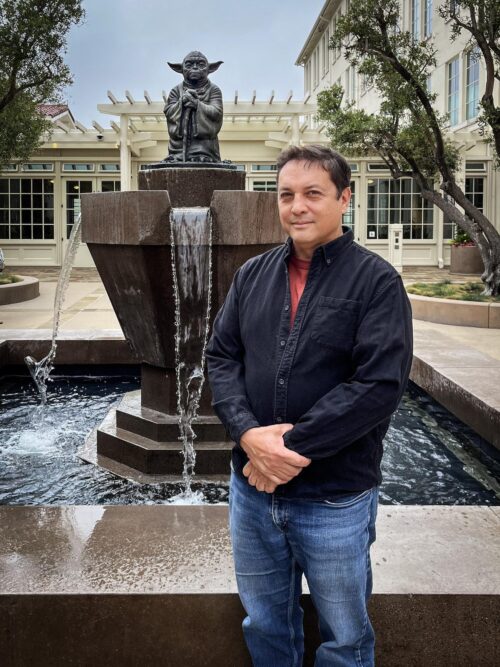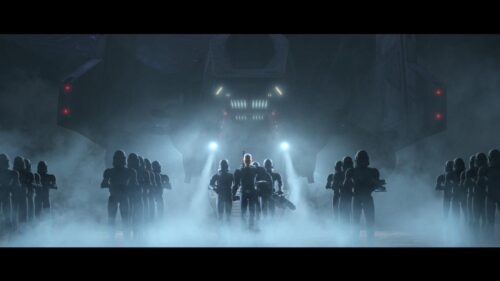
Paul Zinnes (BA ’88 LAS, MFA ’91 Industrial Design)
Difficult to see. Always in motion is the future.
By Amy Karagiannakis
If you asked Paul Zinnes in 1977 what he wanted to do when he grew up, he probably would have told you, “I want to make Star Wars.” At age 11, that sounded like a pretty cool job after seeing the blockbuster movie in theaters, but what did that mean, and how do you get involved in something like that? It took many years and four important life-changing decisions later before Zinnes fulfilled his childhood dream of making Star Wars.
Paul Zinnes, director of digital assets for Lucasfilm Animation, grew up in Champaign and attended University Laboratory High School. Zinnes was a few years into his undergraduate education in chemistry at the University of Illinois when he realized that he wasn’t really enjoying it, and he couldn’t picture a rewarding career in front of him if he continued down that path. It was the late 1980s, and at a time when technology was advancing rapidly, the industrial design field was very attractive. He managed to take some industrial design courses at the School of Art and Design during his senior year, and after graduation, he enrolled in the Industrial Design master’s program.
While attending graduate school, Zinnes worked as a graduate assistant for campus recreation. Shortly after completing his degree, he accepted a more professional position with the university which afforded him the opportunity to take courses for free. With the release of groundbreaking movies like Jurassic Park and Terminator 2 at that time, Zinnes became very interested in computer graphics and wondered what it would take to get into that field. It was at this moment, when he made the first decision that played a critical role in his career path. There was an artist-facing computer graphics course, taught by School of Art and Design Professor Donna Cox, that was very selective. In fact, students were required to interview with Professor Cox before enrolling. Zinnes recalled, “I was standing on the steps of the Art and Design Building that day, trying to decide if I should just go back to my office across the street to get some work done or make the effort to get to Donna’s class at the Beckman Institute. I decided to go. That night, I got a call from Donna, and she said, ‘You’re in.’ That was it.”
It was this class, and the experience he gained from working in the computer lab with Professor Cox, that ultimately launched Zinnes into the field of computer graphics. The technology and facilities on campus were the very same programs being used at big studios which allowed him to gain valuable skills that ultimately prepared him for a career in this new field. Fast forward to the second significant decision in Paul Zinnes’s career.
In 1995, he decided to submit a few frames of animation that he had been working on to the juried computer animation festival at SIGGRAPH, the annual conference on computer graphics. After a few months had passed and well after he stopped working on the project, Zinnes was notified by the organizers that he had been selected to present at SIGGRAPH. He worked day and night, spending countless hours in the lab with the support of Donna Cox and her team, to render frames and finish the animation project. The completed animation was shown at the festival, and immediately opened up many opportunities to interview at some of the most prominent computer animation studios in the world. Zinnes had several interviews lined up at SIGGRAPH, including Industrial Light & Magic (ILM) and Pixar. However, it was a small poster with a stormtrooper on it that said, “LucasArts wants you,” that really captured Zinnes’s interest. He considered applying but knew that he would have to take a taxi across town to drop off his demo reel. Ultimately, he made that third critical decision to give it a shot. Before the day was over, he got a call to interview with LucasArts, and though they were interested, they just didn’t have a position for him at that time. A few days later he was offered a job with Cyan, the creators of Myst, which at the time was the best-selling PC game on the market. When Zinnes let LucasArts know that he was offered a job, they immediately flew him out to San Francisco to meet with them. After the interview, LucasArts invited him to lunch at Skywalker Ranch, which Zinnes described, “We sat down, and after a little while I notice George Lucas walk in and sit down for lunch across the room. I said, ‘Ok I’m in. Sign me up.’”
Paul Zinnes worked on a number of LucasArts video games in the five years he was with the company, and it was that fourth major life decision to accept their job offer over Cyan that allowed him to build this network within the Star Wars franchise. His favorite Star Wars project would come about many years later when he was recruited to Lucasfilm to work on the animated series The Clone Wars. This was one of the last Star Wars projects George Lucas directly worked on. Lucas decided to build a team from scratch that could fulfill his vision to create an episodic CGI animated Star Wars television series. Zinnes was one of the core members of this team assembled at Skywalker Ranch in Marin County, CA. They met with George Lucas on a regular basis as they worked through creating what Lucasfilm referred to as “the next generation of the Star Wars saga.”

Paul Zinnes (BA ’88 LAS, MFA ’91 Industrial Design)

Scene from Star Wars: The Bad Batch
part 2
Now with over 25 years of experience in video games, feature film visual effects, and episodic broadcast animation, Paul Zinnes can legitimately say, I make Star Wars. He doesn’t though, because he’s incredibly humble and credits the many creatives he works with nationally and internationally each day to bring fans what they love. Zinnes explained, “It’s really a team effort. I’m like the general contractor for our shows. We have a design department with incredibly talented concept artists that create a blueprint of sorts for the characters, environments, props, and vehicles. I get all of these drawings for what the spaceships should look like, what the planets should look like. It’s up to me then to figure out, how do I build this?” As to what’s next in that galaxy far, far away, Zinnes says he’s looking forward to the release of season 2 of The Bad Batch, which he says, “represents some of the team’s finest work and storytelling.” Beyond that, Zinnes remains tight-lipped other than to say, “we always look to amaze, surprise, and entertain our fans.”

Scene from Star Wars: The Bad Batch